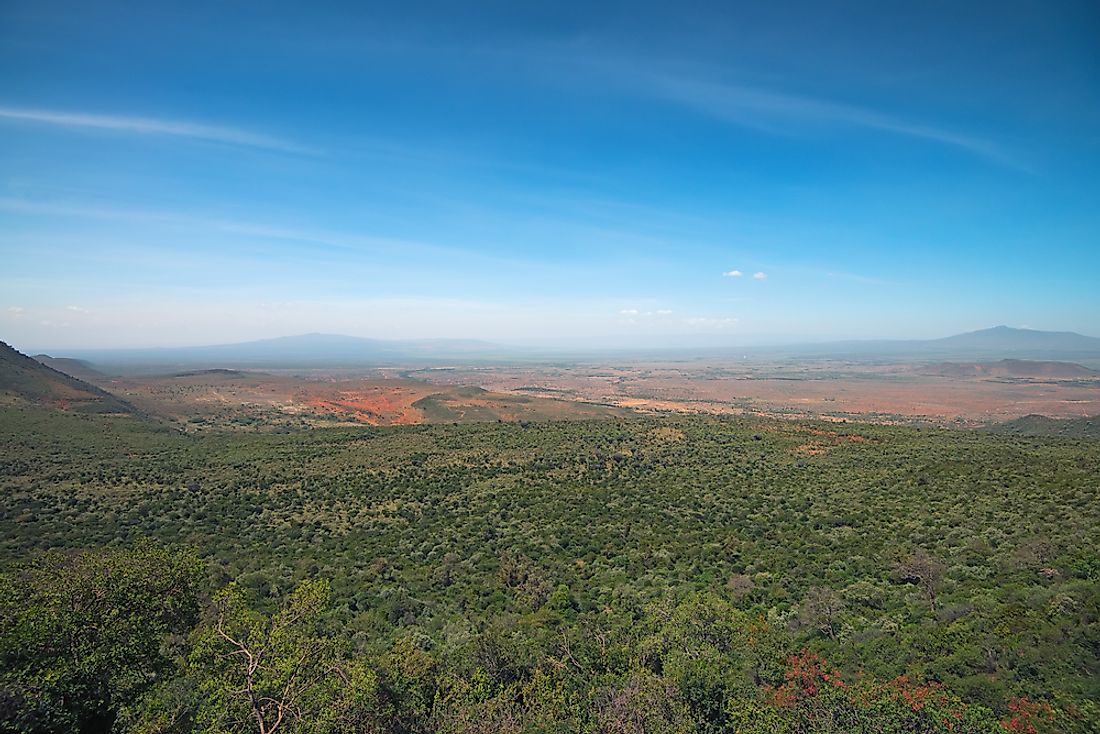What Is a Rift Valley?

A rift valley is a huge fracture on continental and oceanic plates which widens gradually over extensive periods of times. A rift valley is a landform whose formation is triggered by a geologic rift or fault. The landform manifests as an elongated lowland in the middle of mountain ranges or several highlands. The depressed regions of a rift valley are created by one or more grabens. A graben is a valley having faults of two or more sides set up by the divergence of tectonic plates. When the tensional forces are strong enough to make the plates to split apart, the central block drops between the two blocks at its flanks and creates a graben. The dropping of the central block creates almost steeply dipping walls of the rift valley when it is still young. The process is the beginning of a rift valley and the valley continues to widen until it becomes a huge basin that fills with sediments from the rift walls and the surrounding area.
Size And Location Of Rift Valleys
Rift Valleys are typically long and narrow, stretching for hundreds of miles. A 37-mile wide depression, for example, occurs in East Africa along the Great Rift Valley. A rift valley’s walls may stand at heights of hundred feets, and they drop away in the form of terraces and steps. Rift valleys occur on the continents as well as on the ocean floor where they arise from seafloor separation. On the continents, rift valleys form in divergence zones of tectonic plates.
Earth’s Rift Valleys
Earth’s most extensive rift valley occurs as a result of seafloor spreading, and is situated along the mid-ocean ridge system’s crest. The East Pacific Rise is one example of this kind of rift valley. Numerous rift valleys exist as part of “triple junctions” which is a type of divergent boundary featuring three tectonic plates meeting at about 120º angles. Two arms of this junction may split to create an ocean while the third (aulacogen) can become a rift valley. Two of this kind of rift valleys are currently active namely the Baikal Rift Zone and the East African Rift in addition to a third speculated to be the West Antarctic Rift. In the case of such rift valleys, tectonic plates are gradually breaking to form new plates and may ultimately become oceanic rifts. Another type of rift valleys occurs as a result of bends in faults moving horizontally. When these bends move in the same direction to that of the relative movements along the faults, extension occurs.
Examples Of Continental Rift Valleys
The Rio Grande Rift Valley extends from the central part of Colorado to Chihuahua in Mexico. It separates the Colorado Plateau from the older region (craton) of the North American Plate. The Baikal Rift Valley stretches for 1200 miles in Siberia in the eastern part of Russia. It occurs at a divergence point as the Amur Plate has been gradually detaching itself from the Eurasian Plate. The West Antarctic Rift Valley features a series of smaller rifts which separate East and West Antarctica. This rift valley has proven difficult to assess as it lies under the Antarctic Ice Sheet which can be over 1.2 miles thick. The most notable rift valley is perhaps the Great Rift Valley which extends from the Middle East down to Mozambique. It is geologically active and such events as earthquakes and volcanoes are common occurrences.
Rift Valley Lakes
Some the largest lakes in the world are situated in rift valleys. Lake Baikal lies in Siberia, and it is the world’s deepest lake. The second deepest lake in the world, Lake Tanganyika, is located in the East African Rift. Lake Vostok is recognized as the largest subglacial lake, and it is speculated to lie in an old rift valley. The Ottawa-Bonnechere Graben rift valley is home to Lake Timiskaming in Quebec and Lake Nipissing in Ontario.











